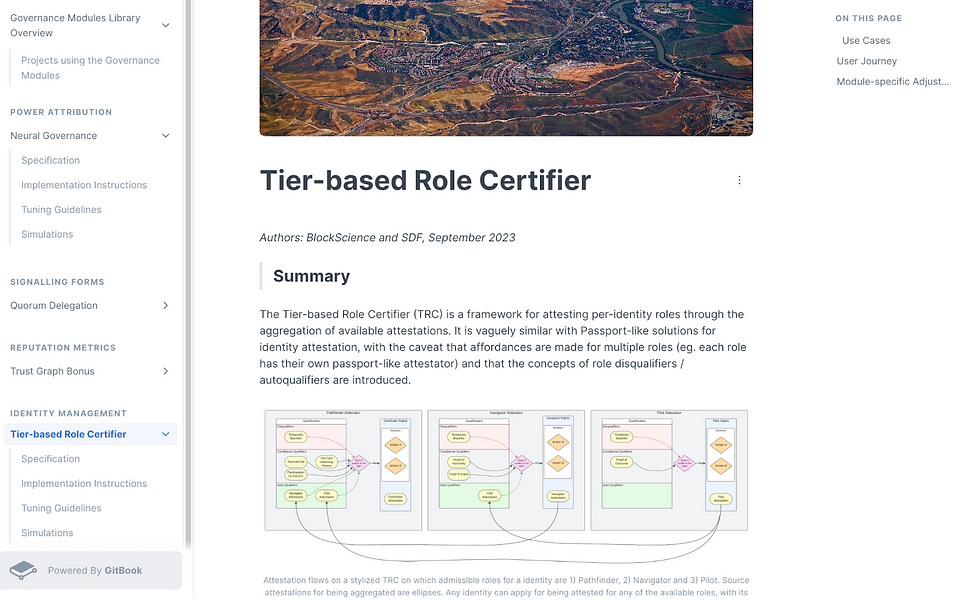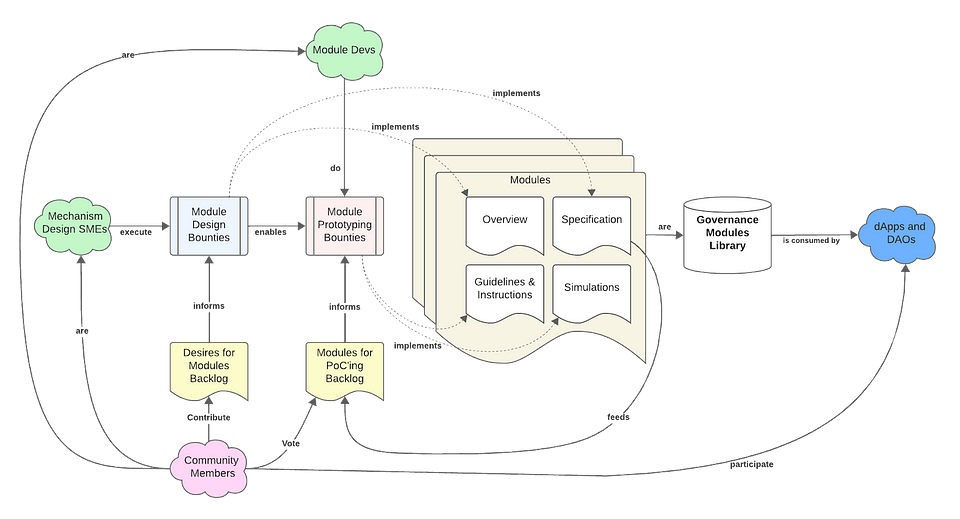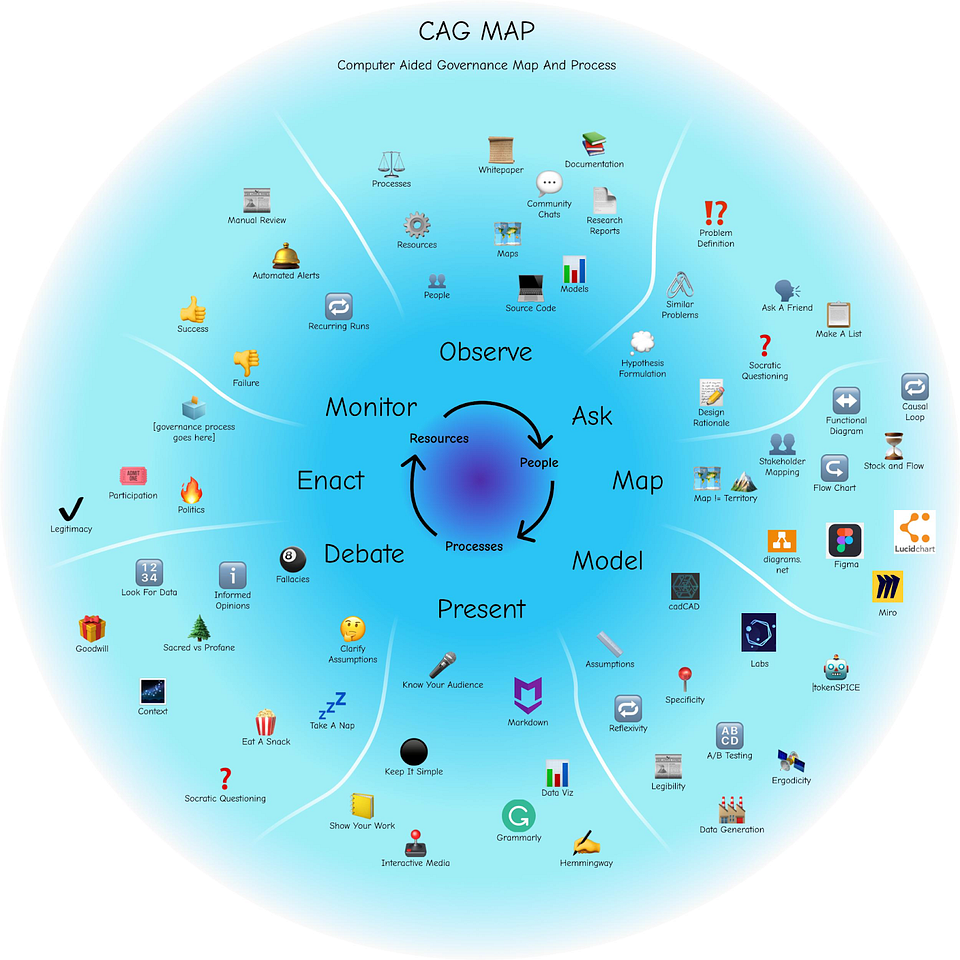Facilitating Computer-Aided Governance with Specs, Documentation, and Simulations
In this post, we introduce the Governance Modules Library (GML), a platform-agnostic collection of computational governance-aiding modules that are enabled for a variety of contexts, such as power attribution, identity, rights management, and more.
This is the final article of a three-part series on the collaboration between BlockScience and Stellar Development Foundation (SDF). Part 1, Introducing Neural Quorum Governance (NQG), explained the novel governance mechanism, and Part 2, The Story Behind Neural Quorum Governance, walked readers through the engineering design principles process and the journey of ideation and prototyping of NQG.
With these and ongoing efforts, the Stellar Development Foundation aims to spread best practices and develop practical, innovative mechanisms to help accelerate the development and adoption of the Soroban protocol and application ecosystem.
What is the Governance Module Library?
“A complex system that works is invariably found to have evolved from a simple system that worked. A complex system designed from scratch never works and cannot be patched up to make it work. You have to start over with a working simple system.”
-Gall’s Law¹
The Governance Modules Library (GML) is a curation of new and classic modules for governance in decentralized applications (dApps) and decentralized autonomous organizations (DAOs). The specifications are platform agnostic, although the implementation guidelines and examples are focused on Soroban, a Rust-based smart contract platform. The stated goal for GML is to spread best practices and innovation as well as to accelerate the adoption of Soroban as an ecosystem by providing a “batteries-included experience” — providing a complete toolkit and instructions set for enhancing DAOs and dApps governance. An example of the experience, an overview of one of the modules (the Tier-based Role Certifier), can be seen in the screenshot as per Fig. [GML-photo].

Governance Modules are templates that can be readily implemented and tuned to specific applications that depend on or require governance solutions. Because Governance is a wide topic, the library is categorized by templates across typical Web3 use cases, such as:
1. How to attribute numerical power to a user (Power Attribution)
2. How to funnel that power through specific signals (Signaling Forms)
3. How to associate identity and/or rights with a user (Identity / Rights Management)
4. How to generate representative signals from behavioral and/or reputational components (Reputation Metrics)
Those use cases are by no means exhaustive, and further categorizations may arise as inspired by other governance research and development efforts such as distilling Metagov’s Govbase, a warehouse of datasets related to online community governance. Fig. [GML] provides a summary of those different categories and some potential modules.

Each Governance Module on the GML consists of a series of documents and examples-by-simulation that describe at least the following: 1) Summary, 2) Use Cases, 3) User Journey, 4) Module-specific Adjustments, 5) Specification, 6) Implementation Instructions, 7) Tuning Guidelines, and 8) Simulations.
This library is intended for community governance and development. As such, it contains documentation for each module as well as a Proof of Concept (PoC) through simulations. Documentation can be found on this HackMD site and demos can be found in this GitHub repo.
The GML authors suggest teams expanding the library should indicate the primary authors (individuals and/or organizations) and a date on any pages they create. Any further modifications and/or contributions can be acknowledged and/or listed as authors.
What does the Governance Module Library enable?
In keeping with the Stellar ecosystem “batteries included” philosophy, the Governance Modules Library is intended to support SDF’s goal of positioning Soroban as a go-to platform for governance-oriented dApps and DAOs, by providing a comprehensive set of readily implementable and tuneable solutions for a variety of governance circumstances.
The GML is not intended to be static but rather embraced by the ecosystem as a source and destination for Governance Modules. Innovators have the opportunity to contribute and receive recognition for publishing and refining Governance Modules.
As the community feeds the GML through backlogs, capturing their desire and expectations for new modules, further development work could be incentivized through bounties, hackathons, and related mechanisms. By formalizing these desires into specifications, a new backlog can be formed: one centered around prototyping the modules themselves, which in turn informs the implementation guidelines on the GML. A potential flow for how this might turn out can be seen in Fig. [Contrib].

The GML is also expected to be empowering for developers who require thoughtful and readily available solutions that are pre-validated under a variety of use cases and situations benefitting dApps and DAOs — the main recipients of the curated modules.
What is already in the Governance Module Library?
Initially, the GML includes three modules: Neural Governance (NG), Quorum Delegation (QD), and the Tier-based Role Certifier (TRC). Here we provide some highlights on two of them: TRC and NG. Further detail can be found in our other two blog posts, as well as in the GML itself.
1. The Tier-based Role Certifier (TRC) is a solution for managing which roles an identity should have. It does so by emitting role attestations through the aggregation of available attestations. It is vaguely similar to Passport-like solutions (such as Gitcoin Passport) for identity attestation, with the caveat that affordances are made for multiple roles (e.g. each role has its passport-like attestation provider) and that the concepts of per-role qualifiers (which can disqualify, conditionally qualify or automatically qualify a user for a rule) are introduced. A visualization of the role attestations can be seen in Fig. [TRC] and a full description of the mechanics can be found in the specification and simulations in the GML.

Some TRC use cases include:
Managing identity rights on role-based systems: TRC allows for expressing differentiated rights across identities on a single system by setting different sets of attestations for each role that encodes those rights.
Representing hierarchical-like roles in terms of rights and required attestations: TRC allows the creation of dependence and/or fast-track pathways towards roles that require more layers of attestations. Is Role B only possible if Role A was acquired beforehand? Does acquiring Role C automatically associate Role B and A regardless of the path? TRC allows for a generalized form to express all of these scenarios.
2. Neural Governance (NG) is a framework for defining a User’s Voting Power for a given project by using the abstractions of Voting Neurons, which are arranged and aggregated together in layers. Each Voting Neuron represents an independent piece of logic on how a User’s Voting Power should be defined and consists of an Oracle Function and a Weighting Function, whereas the first encodes the core logic and the second encodes how it should be weighted. The outputs from all Voting Neurons are aggregated together in layers and then passed as input to the next layer until a final value is reached
Some use cases for NG include:
Public Goods funding allocation: Neural Governance allows administrators to enable purpose-specific Neurons, adapting the governance of funds allocation to a specific set of restrictions. For Public Goods funding allocation, this allows for enabling Neurons that incorporate signals such as prior network participation, prior voting history, experience with Public Goods, and more. Additionally, NG allows a community to easily and legibly adjust weights on those signals, which can enable a community to more effectively steer funds towards projects that might have fared worse under conditions engineered for for-profit investments.
Domain-specific expertise representation: Similar to above, NG also allows a community to set Neurons for a particular governance action to be weighted more towards individuals with a particular set of expertise — such as technical engineering work, social impact work, or academic background. The NG framework is flexible enough to adapt individual Neurons to accept and weigh inputs according to community requirements.
Adaptive governance: As NG accepts inputs at each layer, transforming them into weighted outputs for the next layer, it also allows for cross-round adaptations. As a starting point, we consider prior voting actions to be an important signal for future voting power allocations. Similarly, one might consider the results of those voting actions — project success and other outcomes — as inputs to future voting rounds. This ongoing feedback, with governance setting weights in between rounds, can enable a community to build up and adapt voting power for various scenarios over long periods.
Finally, the GML includes the description for further modules (as per this post, one for the Trust Graph Bonus reputation metric and another one for the Quorum Delegation signaling form). We expect the coverage to increase with time as the adoption and ownership of the GML are consolidated by the community.
Conclusions & Next Steps
The Governance Modules Library enables knowledge sharing across organizations and platforms and aims to support dApps and DAOs in consolidating best practices, building on, and experimenting with governance tool deployment. The Stellar Development Foundation hopes it will also accelerate the adoption and positioning of Soroban as a go-to platform for governance-oriented decentralized applications. By providing specifications, simulations, tuning and implementation guidelines, and use cases, the GML will facilitate innovation in the ecosystem.
It is important to remember that governance modules are contextual and need to be adapted over time. Tracking context and adaptations through a clear structure of description, validation, and implementation context allows for better conversations and clearer (dis-)agreement over requirements and goals. The GML only fulfills its long-term goals if the community decides to interact with it, adapting and taking ownership of it over time. It does not stand in isolation but provides additional development and community experience over a shared infrastructure.
At a more high level, the GML has several promising links with other initiatives in the ecosystem. For instance, the GML modules could be direct solutions for several steps that are laid out in the Computed Aided Governance Map and Process (CAG MAP), which is an exploration of how computation can be used for understanding and steering complex systems through the Observe, Ask, Map, Model, Present, Debate, Enact and Monitor feedback loop (fig. [CAG]).

The GML effort is also closely related to the research being done by the Metagovernance Project, an interdisciplinary research collective, and particularly the group’s projects Govbase (a warehouse of datasets related to online community governance), PolicyKit (a proposal for a decentralized governance layer), and Metagov Gateway (an API gateway for exposing governance solutions for online communities).
Article written by Danilo Bernardineli and Jakob Hackel, with contributions and reviews provided by Jessica Zartler, Jeff Emmett, David Sisson, Daniel Furfari, Kelsie Nabben, Anke Liu, Alejo Mendoza, Giuliano Losa, and SCF verified members.
Header image: An artist’s illustration of the Governance Modules Library by Viola Sellerino
[1] Gall, J. (1975). General Systemantics. Quadrangle/The New York Times Book Co.
About BlockScience
BlockScience® is a complex systems engineering, R&D, and analytics firm. By integrating ethnography, applied mathematics, and computational science, we analyze and design safe and resilient socio-technical systems. With deep expertise in Market Design, Distributed Systems, and AI, we provide engineering, design, and analytics services to a wide range of clients including for-profit, non-profit, academic, and government organizations.
🐦Twitter | 📚 Medium | 👻Blog | 🎥 YouTube | 👥Linkedin
About Stellar Community Fund
The Stellar Community Fund (SCF) is an open-application awards program managed by the Stellar Development Foundation to support developers and startups building on Stellar and Soroban. SCF relies on input from verified members in the Stellar community for award allocation, governance and project support to keep the fund running and developing. Review rounds run monthly and projects can request up to $100K worth of XLM at a time.
About Stellar and Soroban
Stellar is a public and open-source blockchain network for payments, on- and off-ramps, and tokenization. It is powered by the Stellar Consensus Protocol (SCP), which is a federated proof-of-agreement consensus mechanism. Soroban is a Rust / WASM / JSON-RPC based smart contract platform which is designed to be sensible, built-to-scale, batteries-included, and developer-friendly. It is meant to have seamless integration with the Stellar network and is currently live on Testnet.
About Stellar Development Foundation
The Stellar Development Foundation (SDF) is a non-profit organization that supports the development and growth of Stellar, an open-source network that connects the world’s financial infrastructure. Founded in 2014, the Foundation helps maintain Stellar’s codebase, supports the technical and business communities building on the network, and serves as a voice to regulators and institutions. The Foundation seeks to create equitable access to the global financial system, using the Stellar network to unlock the world’s economic potential through blockchain technology. For more information, visit stellar.org/foundation.


